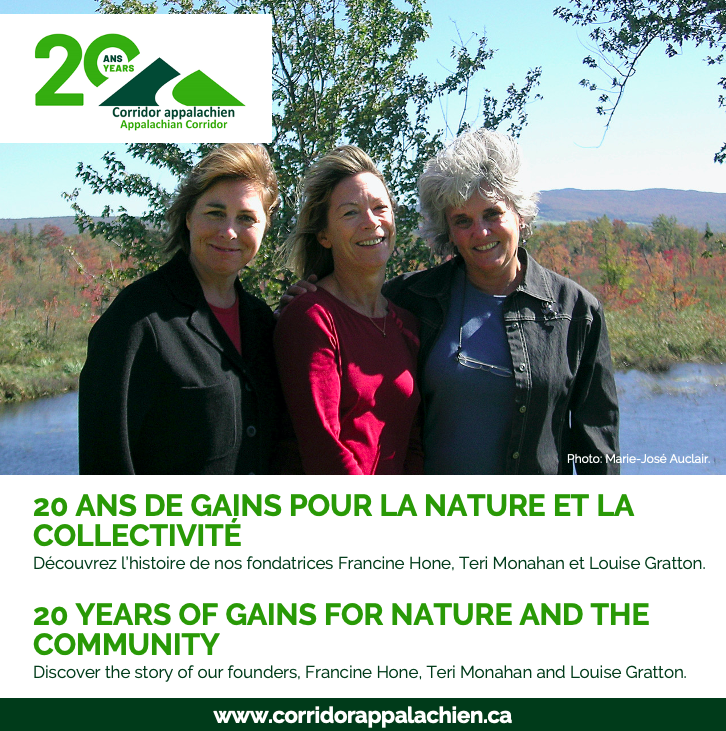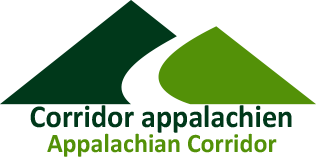
26 Apr 20 YEARS OF GAINS FOR NATURE AND THE COMMUNITY: THE BIRTH OF APPALACHIAN CORRIDOR

Appalachian Corridor is a conservation organization dedicated to creating a vast network of protected areas in perpetuity. Founded in 2002, the organization has contributed to the protection of more than 15,500 hectares of land by working closely with the Nature Conservancy of Canada, its 17 affiliate members as well as several funders and donors. On its 20th anniversary, we take the opportunity to look back at the moments, people, and places that have marked two decades of gains for nature and communities.
In this story, Louise Gratton, biologist, and co-founder of Appalachian Corridor, tells us about the people and circumstances that set the table for the creation of a common vision for the conservation of our vast territory, the precious Appalachians of southern Quebec.

Co-founders of Appalachian corridor: Francine Hone, Terri Monahan, Louise Gratton.
(Photo by Marie-José Auclair)
By Louise Gratton, biologist and co-founder of Appalachian Corridor
The beginning of the Appalachian Corridor is a story punctuated with new friendships, coincidences, and science.
It should be remembered that, as early as 1991, the Ministère des Loisirs, de la Chasse et de la Pêche had selected the Sutton Mountains region as a potential project in a network of regional parks that it had the mandate to establish.
Supported by the World Wildlife Fund (WWF) as part of the Endangered Spaces campaign, the Parc d’environnement naturel de Sutton (PENS), with the collaboration of conservation organizations (1), proposed the creation of a regional park (2) and submitted a provisional plan for its implementation (3).
Most of the territories involved in this project were privately owned, unlike the other regional park projects, which were all on public land. The challenge was quite significant, and its realization was compromised. However, the groundwork for a conservation project in the region remained fertile.
The origin of the Appalachian Corridor cannot be linked to a single event but rather to a combination of circumstances.
Here are the main ones:
- Justin Manasc of For-éco had done some silvicultural work on one of the properties of the Ruiter Valley Land Trust (RVLT). He recommended my services to Terri Monahan, then president of the RVLT, to create interpretive signs along the trails. This was my first local contract since moving to the area in the summer of 1997. Terri and I quickly became friends and, in the process, over the next few years, I learned about several other land trusts in the area, the PENS, and their amazing missions.
- At that time, I was on the board of Nature Canada where I was in contact with Peter Lee of Forest Watch Canada. One day, he showed me a map of the state of Canada’s forests showing unfragmented forest areas larger than 100 km2. In southwestern Quebec, there were only two left: a large forest block north of Parc national du Mont-Orford and the Sutton Mountains, located in my backyard. Following the example of organizations that had understood it long before me, I recognized the incredible potential of this vast forest ecosystem in terms of biodiversity.
- In the early 2000s, I spoke with Nathalie Zinger, then director of the WWF-Quebec office, to share this observation. Good timing: She was about to relaunch conservation in the Sutton Mountains region as part of the “Endangered Spaces” campaign. I volunteered to bring together representatives of the trusts and PENS at my home. At this meeting, she was accompanied by Francine Hone, a conservation consultant for the WWF. We all agreed to restart a project more focused on the protection of this priority site in southern Quebec. WWF provided initial funding to RVLT to describe the conservation issues and priorities in the Sutton Mountains (4). This report was based on criteria developed by internationally renowned conservation biologist, Reed Noss (5), for maintaining ecological integrity in a representative network of protected areas. A companion document, prepared for the Nature Conservancy of Canada, already identified properties that could be the first acquisitions.

As we were learning about the new science of conservation biology, it became clear that protecting the Sutton Mountains alone would not be enough. Thus, in parallel, the RVLT submitted a proposal to funders to implement a more ambitious conservation project.
With the support of FFMP, FFMA and PENS, a goal for the region emerged:
This is one of the last wilderness areas in the extreme south of Quebec where large unfragmented woodlands are still essential to maintain viable populations of species that depend on large natural areas for their survival and the only habitats capable of supporting several bird and mammal species that are more demanding of forest habitat. Taking into consideration the natural corridor that extends from the Green Mountains of Vermont to the Sutton Mountains of Quebec, it was possible to create protected areas large enough to satisfy the requirements of these species and to ensure connectivity between them to promote the exchanges (migration, dispersion, genetic flow) essential to the viability of the populations.
The idea of a transboundary conservation strategy (6), inspired by the Yukon to Yellowstone initiative in the west, was therefore launched. Inspired by the renowned Appalachian Trail, the organization dedicated to the conservation of the natural corridor straddling the Appalachian Mountains range adopted the name “Appalachian Corridor” and its foundation was formalized in 2002.
The Appalachian Corridor project, which was initially carried by the RVLT, was now ready to stand on its own.
NOTES
(1) RVLT, FTLB, FFMP, FFMA and other participants at the regional consultation for ecology groups.
(2) Côté, É, J. Manasc and D. Paquette, 1993. Une région…un parc. Parc d’environnement naturel de Sutton, Inc., 20 p.
(3) Parc d’environnement naturel de Sutton, 1996. Parc régional éclaté dans la grande région des monts Sutton : Plan prévisionnel. 67 p.
(4) Gratton, L., T. Monahan and J. Manasc, 2000. Enjeux et priorités de conservation dans le massif des Monts Sutton. Une évaluation préliminaire. Fiducie foncière de la Vallée Ruiter, 23 p.
(5) Noss, R. 1995. Maintaining ecological integrity in representative reserve networks. A World Wildlife Fund-Canada/ World Wildlife Fund-United States Discussion Paper,77 p.
(6) Fiducie foncière de la Vallée Ruiter, 2000. Corridor appalachien. Une stratégie de conservation transfrontalière, 17 p.

